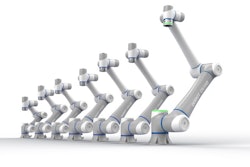
With annual revenue in the U.S. robotics market expected to grow at 5.62% (CAGR), resulting in a market volume of over $9B by 2027, there are several predictions on key trends in in robotics automation in the U.S. for 2023 and beyond.
The impact of U.S. labor shortages is increasingly being felt by many businesses as they struggle to keep pace with customer demands, even with the potential for some softening in the US economy in the short-term. This, combined with global political uncertainty, fragile supply chains, rising material costs, in addition to the growing trend of reshoring and nearshoring of operations, means more companies are adopting robotic automation to maximize flexibility, build resilience and adapt more sustainable production processes.
Trend 1
Demand for robots will increase in response to long term labor shortages and surge in re- and nearshoring.
The impact of labor shortages is clearly felt across a wide range of industries and will continue well beyond 2023 as the effect of aging populations and a reluctance to take on low paid, dull, dirty and dangerous jobs increases. The Congressional Budget Office recently forecast that the size of the U.S. labor force will grow by just 0.2% annually from 2024 to 2031, and by 2030, it is predicted that more than 2.1 million US manufacturing jobs will be unfilled. This will hamper economic growth and present companies with the need to find new ways to plug gaps in workforces.
Demand for robots will be particularly strong in countries where companies are planning to re- or near-shore their operations to help improve their supply chain stability in the face of global uncertainty. In a survey of 1,610 companies carried out by ABB Robotics in 2022, 70% of US businesses said they are planning to re- or near-shore their operations, with 62% indicating they would be investing in robotic automation in the next three years.
While much of the mainstream attention has focused on the impact of automation taking jobs, robots will increasingly perform the physically stressful tasks that people are reluctant to perform, helping to moderate industrial and commercial labor shortages.
We will also see robots taking on tasks in new sectors such as food processing and healthcare. We will see robots taking on more roles in similar settings going forward as labor shortages continue to impact many businesses,
Trend 2
AI and autonomous technology will make robots easier to use, integrate and access – opening up additional opportunities in new industries.
AI solutions enable manufacturers to move away from traditional production lines towards integrated scalable, modular production cells, while optimizing the delivery of components across facilities.
Ongoing developments in AI are powering autonomous grasping and positioning, which will expand the range of tasks robots can perform. This greater use of AI in robotics helps with tasks like the picking of non-uniform objects, is happening at many facilities.
At the same time, continued simplification of the software and controllers used to program robots will further reduce barriers to adoption by removing the need for specialist expertise.
Over the past few years, the capabilities of AI in the robotics realm have improved significantly. As the technology continues to mature and become less complex, enabling ease-of-use and multiple applications, robotics will penetrate segments beyond traditional manufacturing and distribution, such as electronics, healthcare, e-commerce, pharmaceuticals and food service.
Trend 3
More specialist partnerships between industry and educators will support a new era of automation.
With more companies using robots, there is a growing need for workers to learn new skills that will enable them to thrive in an automated environment. Achieving this will require a cooperative, multi-generational approach, from schools, colleges and universities through to SMEs and supporting associations to provide training.
Businesses in the future will need employees with experience in applying automation to perform a variety of processes. As robots become more prevalent in factories, warehouses and other environments, there will be an increase in partnerships between robot OEMs, system integrators, manufacturers and educators to provide people the necessary skills for an automated future.
The Future
As this all unfolds, the successful implementation of robotic automation will require a layer of qualified human engagement to achieve the best possible outcomes. As new technologies continue to make robots easier to use and deploy, 2023 is a year of opportunity that will enable companies and their workforces to reach new levels of productivity, efficiency and flexibility.




![Pros To Know 2026 [color]](https://img.sdcexec.com/mindful/acbm/workspaces/default/uploads/2025/08/prostoknow-2026-color.mduFvhpgMk.png?auto=format%2Ccompress&bg=fff&fill-color=fff&fit=fill&h=100&q=70&w=100)







![Pros To Know 2026 [color]](https://img.sdcexec.com/mindful/acbm/workspaces/default/uploads/2025/08/prostoknow-2026-color.mduFvhpgMk.png?ar=16%3A9&auto=format%2Ccompress&bg=fff&fill-color=fff&fit=fill&h=135&q=70&w=240)







